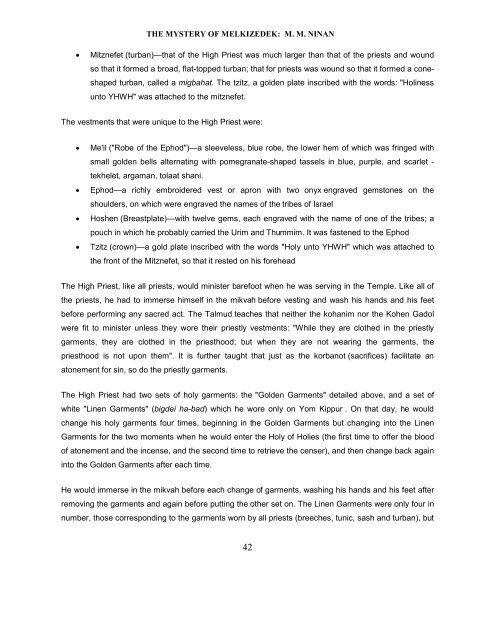Mystery of Melchzedek
Create successful ePaper yourself
Turn your PDF publications into a flip-book with our unique Google optimized e-Paper software.
THE MYSTERY OF MELKIZEDEK: M. M. NINAN<br />
• Mitznefet (turban)—that <strong>of</strong> the High Priest was much larger than that <strong>of</strong> the priests and wound<br />
so that it formed a broad, flat-topped turban; that for priests was wound so that it formed a coneshaped<br />
turban, called a migbahat. The tzitz, a golden plate inscribed with the words: "Holiness<br />
unto YHWH" was attached to the mitznefet.<br />
The vestments that were unique to the High Priest were:<br />
• Me'il ("Robe <strong>of</strong> the Ephod")—a sleeveless, blue robe, the lower hem <strong>of</strong> which was fringed with<br />
small golden bells alternating with pomegranate-shaped tassels in blue, purple, and scarlet -<br />
tekhelet, argaman, tolaat shani.<br />
• Ephod—a richly embroidered vest or apron with two onyx engraved gemstones on the<br />
shoulders, on which were engraved the names <strong>of</strong> the tribes <strong>of</strong> Israel<br />
• Hoshen (Breastplate)—with twelve gems, each engraved with the name <strong>of</strong> one <strong>of</strong> the tribes; a<br />
pouch in which he probably carried the Urim and Thummim. It was fastened to the Ephod<br />
• Tzitz (crown)—a gold plate inscribed with the words "Holy unto YHWH" which was attached to<br />
the front <strong>of</strong> the Mitznefet, so that it rested on his forehead<br />
The High Priest, like all priests, would minister barefoot when he was serving in the Temple. Like all <strong>of</strong><br />
the priests, he had to immerse himself in the mikvah before vesting and wash his hands and his feet<br />
before performing any sacred act. The Talmud teaches that neither the kohanim nor the Kohen Gadol<br />
were fit to minister unless they wore their priestly vestments: "While they are clothed in the priestly<br />
garments, they are clothed in the priesthood; but when they are not wearing the garments, the<br />
priesthood is not upon them". It is further taught that just as the korbanot (sacrifices) facilitate an<br />
atonement for sin, so do the priestly garments.<br />
The High Priest had two sets <strong>of</strong> holy garments: the "Golden Garments" detailed above, and a set <strong>of</strong><br />
white "Linen Garments" (bigdei ha-bad) which he wore only on Yom Kippur . On that day, he would<br />
change his holy garments four times, beginning in the Golden Garments but changing into the Linen<br />
Garments for the two moments when he would enter the Holy <strong>of</strong> Holies (the first time to <strong>of</strong>fer the blood<br />
<strong>of</strong> atonement and the incense, and the second time to retrieve the censer), and then change back again<br />
into the Golden Garments after each time.<br />
He would immerse in the mikvah before each change <strong>of</strong> garments, washing his hands and his feet after<br />
removing the garments and again before putting the other set on. The Linen Garments were only four in<br />
number, those corresponding to the garments worn by all priests (breeches, tunic, sash and turban), but<br />
42


















